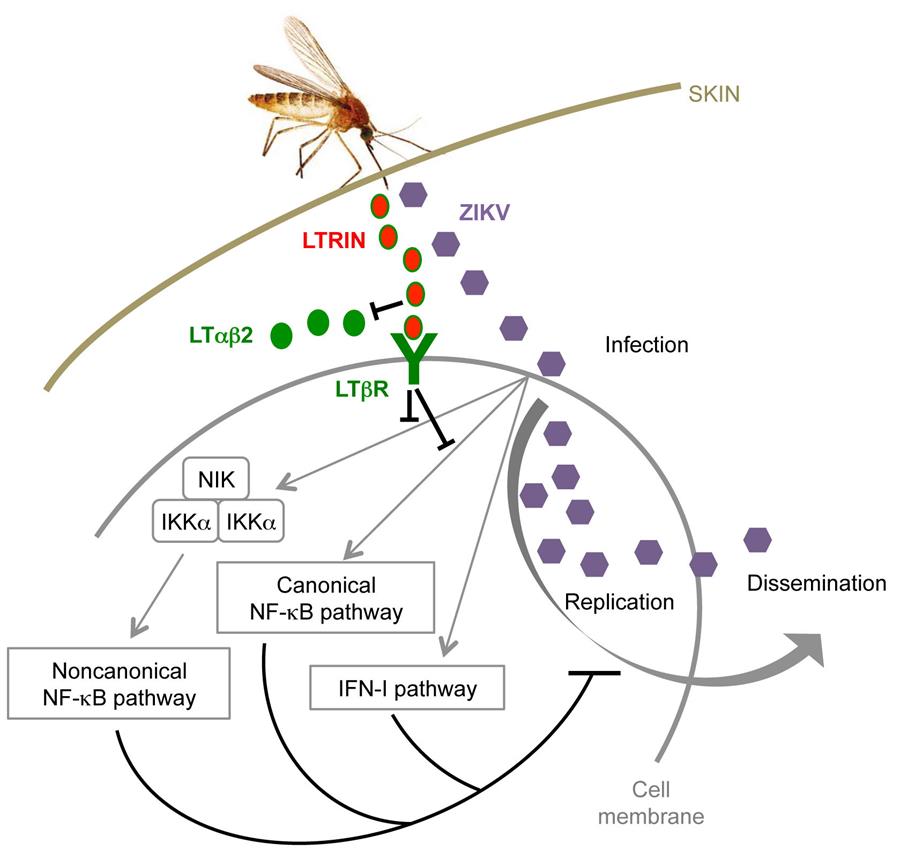Salivary factor from Aedes aegypti facilitates Zika transmission
Source:Ren Lai
2018-04-10
Identified in the 1940s in Africa, Zika is primarily spread by the bite of an infected mosquito. It can be passed from a pregnant woman to her fetus, leading to defects in infants, including microcephaly that causes abnormally small brains and heads. Since 2015, the Zika virus has swept through more than 60 countries. The epidemic led the World Health Organization to issue an alert in December 2015. There is currently no vaccine or treatment for Zika.
LAI Ren from Kunming Institue of Zoology, Chinese Academy of Sciences, and colleagues have found that LTRIN, a protein obtained from the salivary glands of Aedes aegypti, or yellow fever mosquito, facilitates the transmission of the Zika virus. LTRIN was upregulated in blood-fed mosquitoes, and it facilitated ZIKV transmission and exacerbated ZIKV pathogenicity by interfering with signaling through the lymphotoxin-β receptor (LTβR), a member of the tumor necrosis factor receptor superfamily that protects against virus infection by regulating host immunity. Mechanically, LTRIN bound to LTβR and preferentially inhibited NF-κB signaling and inflammatory cytokines production through interfering with LTβR dimerization during ZIKV infection. Further, anti-LTRIN treatment inhibited mosquito-mediated ZIKV infection, and LTβR abrogation was demonstrated to potentiate ZIKV infectivity both in vitro and in vivo.
This is the first evidence showing that a specific mosquito salivary protein can exacerbate ZIKV pathogenesis in mammalian hosts and that LTR signaling plays a critical role in ZIKV infection. This study sheds light on the process of ZIKV transmission in nature, which will improve our understanding of the causes of ZIKV outbreak and infectivity. Our findings highlight the possible therapeutic potential of modulating LTRIN activity or vaccination of LTRIN to increase host defense against ZIKV infection and to develop effective treatment options for patients with debilitating mosquito-borne diseases.
JIN Lin, GUO Xiaomin, SHEN chuanbin, HAO Xue (Kunming Institute of Zoology, CAS) and SUN Peng (Tsinghua University) are the co-first authors of this paper. CHENG Gong (Tsinghua University), QI Xiaopeng and LAI Ren (Kunming Institute of Zoology, CAS) are the corresponding authors.
This work was supported by funding from the National Key Research and Development Program of China, National Natural Science Foundation of China, Chinese Academy of Sciences and Yunnan Province.

Link to the article: https://www.nature.com/articles/s41590-018-0063-9
LAI Ren from Kunming Institue of Zoology, Chinese Academy of Sciences, and colleagues have found that LTRIN, a protein obtained from the salivary glands of Aedes aegypti, or yellow fever mosquito, facilitates the transmission of the Zika virus. LTRIN was upregulated in blood-fed mosquitoes, and it facilitated ZIKV transmission and exacerbated ZIKV pathogenicity by interfering with signaling through the lymphotoxin-β receptor (LTβR), a member of the tumor necrosis factor receptor superfamily that protects against virus infection by regulating host immunity. Mechanically, LTRIN bound to LTβR and preferentially inhibited NF-κB signaling and inflammatory cytokines production through interfering with LTβR dimerization during ZIKV infection. Further, anti-LTRIN treatment inhibited mosquito-mediated ZIKV infection, and LTβR abrogation was demonstrated to potentiate ZIKV infectivity both in vitro and in vivo.
This is the first evidence showing that a specific mosquito salivary protein can exacerbate ZIKV pathogenesis in mammalian hosts and that LTR signaling plays a critical role in ZIKV infection. This study sheds light on the process of ZIKV transmission in nature, which will improve our understanding of the causes of ZIKV outbreak and infectivity. Our findings highlight the possible therapeutic potential of modulating LTRIN activity or vaccination of LTRIN to increase host defense against ZIKV infection and to develop effective treatment options for patients with debilitating mosquito-borne diseases.
JIN Lin, GUO Xiaomin, SHEN chuanbin, HAO Xue (Kunming Institute of Zoology, CAS) and SUN Peng (Tsinghua University) are the co-first authors of this paper. CHENG Gong (Tsinghua University), QI Xiaopeng and LAI Ren (Kunming Institute of Zoology, CAS) are the corresponding authors.
This work was supported by funding from the National Key Research and Development Program of China, National Natural Science Foundation of China, Chinese Academy of Sciences and Yunnan Province.

Link to the article: https://www.nature.com/articles/s41590-018-0063-9


